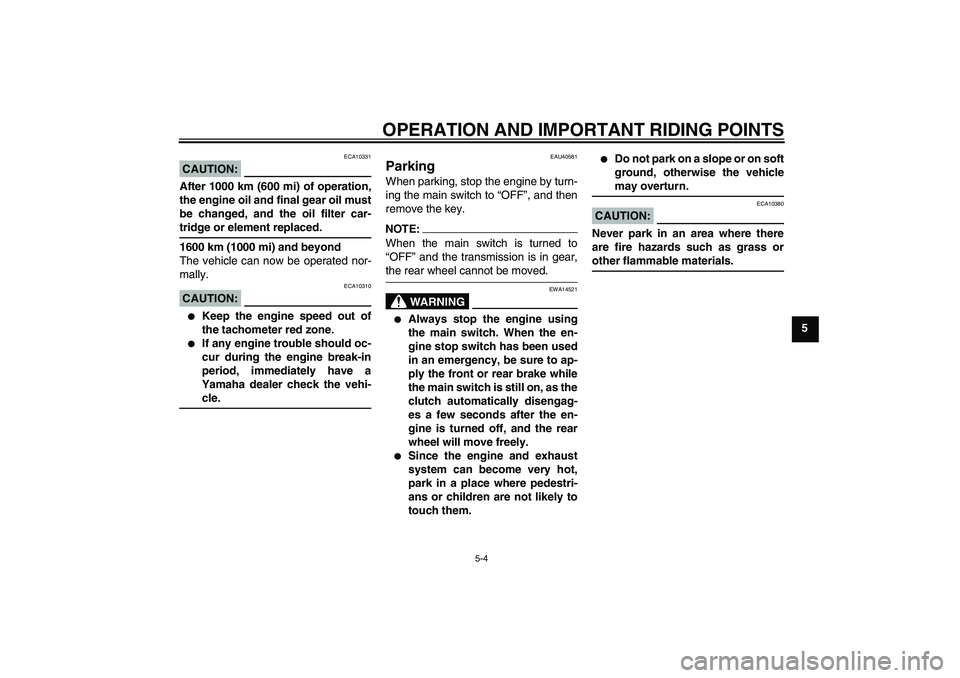Page 15 of 100

INSTRUMENT AND CONTROL FUNCTIONS
3-1
3
EAU40472
YCC-S system This vehicle features the YCC-S
(Yamaha Chip Controlled-Shift) sys-
tem.
The basic function of this system allows
the rider to shift gears without the use of
a clutch lever. Furthermore, a shift lever
is equipped on the handlebar, allowing
the rider to choose to shift gears either
with the shift pedal or by hand.
When the engine is started and the shift
pedal or the shift lever is moved, a sig-
nal is sent to the MCU (Motor Control
Unit) which disengages the clutch, then
the shift is made. The MCU engages
the clutch once the engine is running at
the proper speed. Clutch engagement
is controlled optimally by the MCU ac-
cording to engine r/min, engine require-
ments, and riding conditions. See
“Handlebar switches” (page 3-15) and
OPERATION AND IMPORTANT
RIDING POINTS (page 5-1) for further
explanation of this system.
NOTE:This is not an automatic transmission,
only the clutch system is automatic.The gears must be shifted by the rider.
EAU10972
Immobilizer system This vehicle is equipped with an immo-
bilizer system to help prevent theft by
re-registering codes in the standard
keys. This system consists of the fol-
lowing.�
a code re-registering key (with a
red bow)
�
two standard keys (with a black
bow) that can be re-registered with
new codes
�
a transponder (which is installed in
the code re-registering key)
�
an immobilizer unit
�
an ECU
1. Code re-registering key (red bow)
2. Standard keys (black bow)
U2D2EAE0.book Page 1 Monday, June 26, 2006 2:55 PM
Page 22 of 100

INSTRUMENT AND CONTROL FUNCTIONS
3-8
3
�
a fuel reserve tripmeter (which
shows the distance traveled on the
fuel reserve)
�
a clock
�
a fuel meter
�
a coolant temperature meter
�
a transmission gear display
�
an ambient temperature display
�
a fuel consumption display (instan-
taneous and average consumption
functions)
�
a self-diagnosis device
NOTE:Be sure to turn the key to “ON” before
using the “SELECT” and “RESET” but-tons.Odometer and tripmeter modes
Pushing the “SELECT” button switches
the display between the odometer
mode “ODO” and the tripmeter modes
“TRIP 1” and “TRIP 2” in the following
order:
ODO → TRIP 1 → TRIP 2 → ODO
NOTE:When selecting “TRIP 1” or “TRIP 2”,the display flashes for five seconds.
When approximately 5.5 L (1.45 US
gal) (1.21 Imp.gal) of fuel remains in the
fuel tank, the display will automatically
change to the fuel reserve tripmeter
mode “F-TRIP” and start counting thedistance traveled from that point. In that
case, pushing the “SELECT” button
switches the display between the vari-
ous tripmeter and odometer modes in
the following order:
F-TRIP → TRIP 1 → TRIP 2 → ODO →
F-TRIP
To reset a tripmeter, select it by push-
ing the “SELECT” button, and then
push the “SELECT” button for at least
one second while the display is flash-
ing. If you do not reset the fuel reserve
tripmeter manually, it will reset itself au-
tomatically and the display will return to
the prior mode after refueling and trav-
eling 5 km (3 mi).1. Odometer/tripmeter/fuel reserve tripmeter
2.“SELECT” button
3.“RESET” button
U2D2EAE0.book Page 8 Monday, June 26, 2006 2:55 PM
Page 55 of 100

OPERATION AND IMPORTANT RIDING POINTS
5-4
5
CAUTION:
ECA10331
After 1000 km (600 mi) of operation,
the engine oil and final gear oil must
be changed, and the oil filter car-tridge or element replaced.
1600 km (1000 mi) and beyond
The vehicle can now be operated nor-
mally.CAUTION:
ECA10310
�
Keep the engine speed out of
the tachometer red zone.
�
If any engine trouble should oc-
cur during the engine break-in
period, immediately have a
Yamaha dealer check the vehi-cle.
EAU40581
Parking When parking, stop the engine by turn-
ing the main switch to “OFF”, and then
remove the key.NOTE:When the main switch is turned to
“OFF” and the transmission is in gear,the rear wheel cannot be moved.
WARNING
EWA14521
�
Always stop the engine using
the main switch. When the en-
gine stop switch has been used
in an emergency, be sure to ap-
ply the front or rear brake while
the main switch is still on, as the
clutch automatically disengag-
es a few seconds after the en-
gine is turned off, and the rear
wheel will move freely.
�
Since the engine and exhaust
system can become very hot,
park in a place where pedestri-
ans or children are not likely to
touch them.
�
Do not park on a slope or on soft
ground, otherwise the vehiclemay overturn.
CAUTION:
ECA10380
Never park in an area where there
are fire hazards such as grass orother flammable materials.
U2D2EAE0.book Page 4 Monday, June 26, 2006 2:55 PM